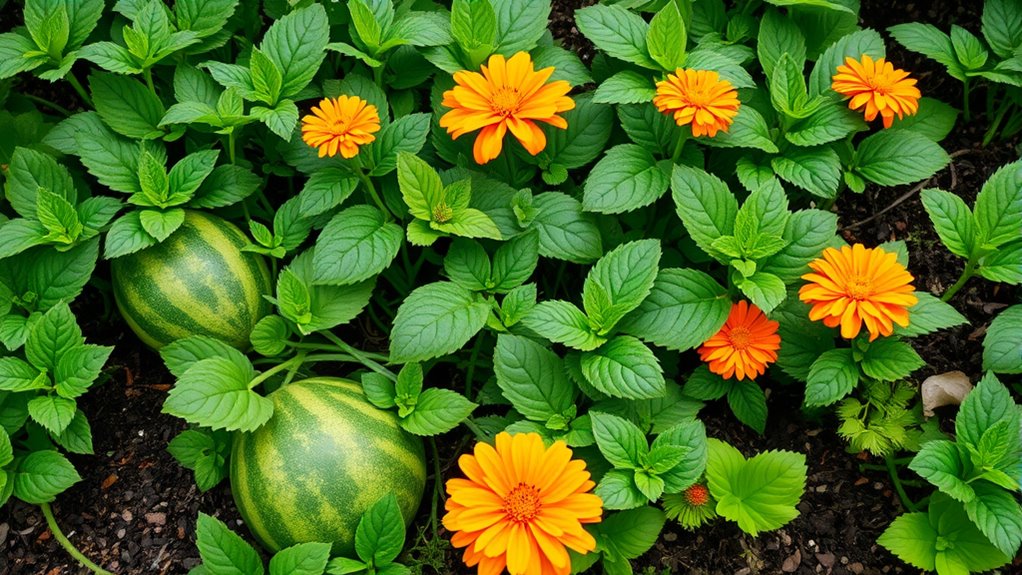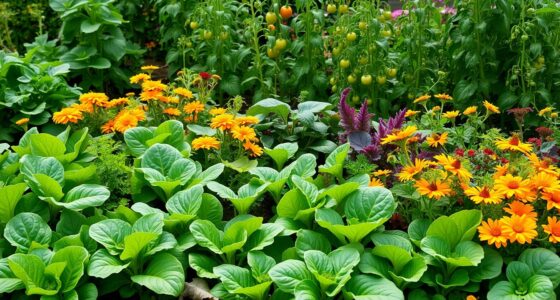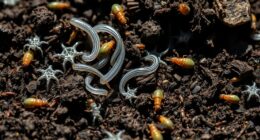For a healthy watermelon crop, plant companions like basil, marigolds, nasturtiums, and radishes nearby. Basil and marigolds help repel pests, while nasturtiums attract beneficial insects and act as natural pest barriers. Radishes improve soil, break up compacted ground, and confuse pests. Adding sweet corn and legumes enriches the soil with nitrogen and attracts pollinators. Eggplants also support pest control and soil health. Keep exploring to discover how these plants work together for a thriving garden.
Key Takeaways
- Companion plants like basil, marigolds, nasturtiums, radishes, and legumes help repel pests and attract beneficial insects to protect watermelons.
- Radishes and legumes improve soil health by fixing nitrogen, loosening soil, and enhancing nutrient availability for watermelon growth.
- Tall plants such as sweet corn provide wind protection, shade, and support pollination for watermelons.
- Bright flowers like marigolds and nasturtiums add visual appeal and promote a balanced, pest-resistant garden ecosystem.
- Interplanting radishes and other quick-growing plants allows efficient space use and natural pest control around watermelons.
Basil
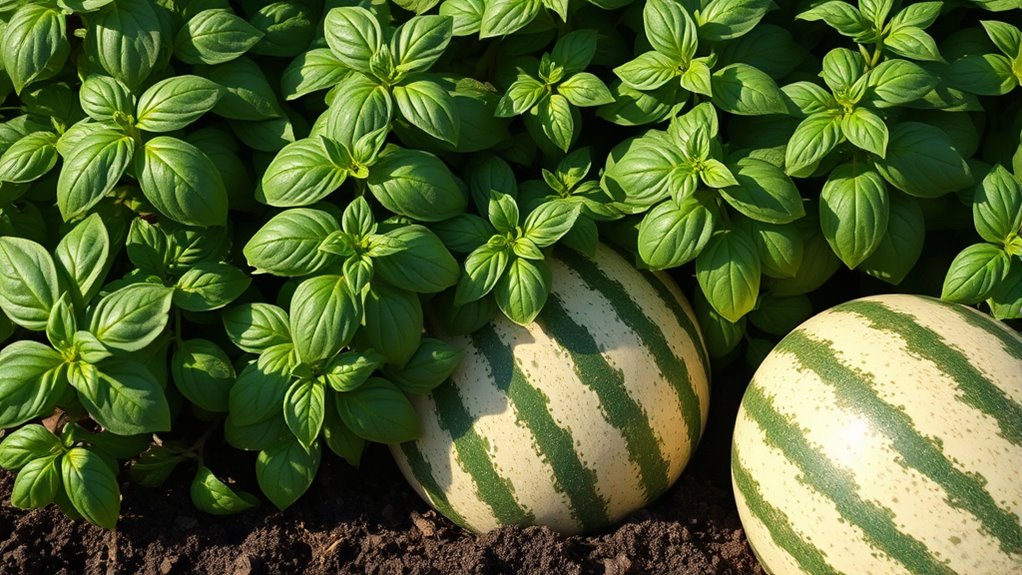
Basil is an excellent companion plant for watermelons because it helps repel pests like aphids and mosquitoes. When you plant basil near your watermelons, you create a natural barrier that discourages these annoying insects from settling on your crop. The strong aroma of basil confuses pests, making it harder for them to locate watermelons to feed on. This means fewer pest-related problems and less need for chemical pesticides. Additionally, basil attracts beneficial insects like pollinators, which can improve fruit development. You’ll appreciate how easy it is to grow basil alongside watermelons, and the combined effort helps maintain a healthy, pest-free garden. Using companion planting principles can further enhance your garden’s health and productivity. Incorporating knowledge about pest deterrents can help you select the most effective plant combinations for your garden’s needs. Employing integrated pest management strategies can further optimize pest control while reducing chemical use.
Marigolds

Marigolds are a popular choice for companion planting with watermelons because they naturally deter many pests that can damage your fruit. Their strong scent repels insects like beetles, aphids, and nematodes, reducing the need for chemical treatments. Planting marigolds around your watermelon vines creates a pest barrier, helping your fruit grow healthy and unblemished. Additionally, marigolds are easy to grow and maintain, thriving in full sun and well-drained soil. Their bright flowers add a splash of color to your garden, making it more attractive. You’ll notice fewer pest problems and healthier watermelons when you include marigolds in your planting strategy. Incorporating integrated pest management practices can further enhance your garden’s health and productivity. Their natural pest-repelling properties are supported by extensive research on companion planting benefits, which show how certain plants can improve crop health. Using marigolds as a biological pest control method can reduce the reliance on chemical pesticides. Incorporating marigolds close to your vines can help create a pest barrier, maximizing their pest-repelling benefits and enjoying a more productive harvest.
Nasturtiums
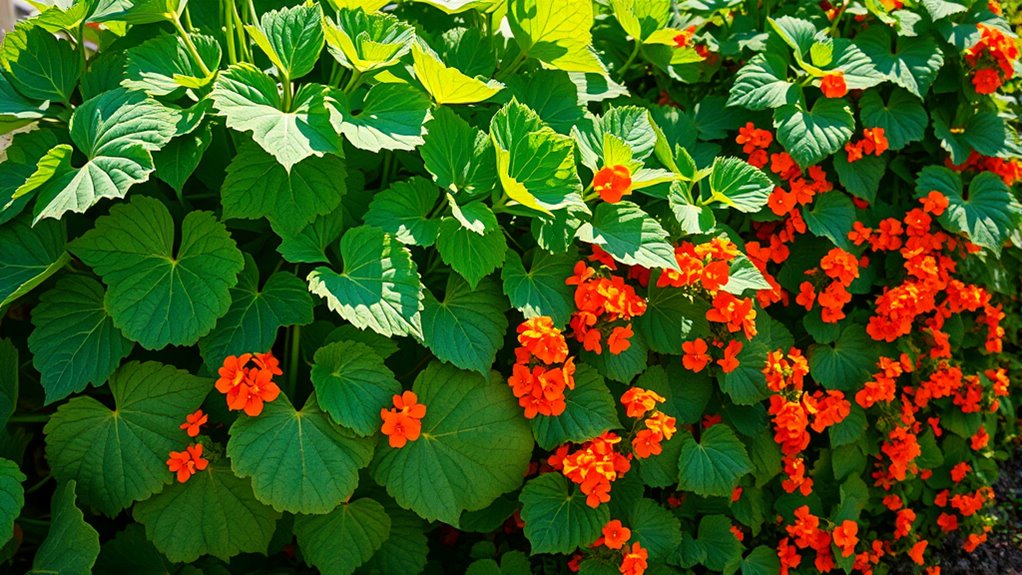
Nasturtiums attract beneficial insects that can help protect your watermelon plants, making your garden more balanced. They also naturally repel pests that often threaten your crops, reducing the need for chemicals. Plus, their bright, colorful flowers add a lovely touch to your garden’s appearance. Incorporating companion planting techniques can further enhance your watermelon harvest. Additionally, planting nasturtiums can contribute to integrated pest management, promoting a healthier garden ecosystem. Choosing plants that support pollinator activity can also increase fruit production and overall plant health. Using plant diversity can create a more resilient garden environment, making your watermelon plants less vulnerable to diseases and pests.
Attracts Beneficial Insects
Because they attract beneficial insects, nasturtiums are an excellent companion plant for watermelons. These flowers draw pollinators like bees, which improve fruit set and increase watermelon yields. Additionally, nasturtiums attract predatory insects such as ladybugs and hoverflies that feed on common watermelon pests like aphids and beetles. By bringing in these helpful insects, you naturally boost your watermelon plants’ defenses without using chemicals. Effective location scouting can help you find optimal spots to plant nasturtiums near watermelons for maximum benefit. Furthermore, incorporating plant diversity in your garden can help create a balanced ecosystem that supports beneficial insect populations and promotes healthy plant growth. Planting nasturtiums near watermelons enhances pollination and pest control, making them a strategic choice for a thriving, organic garden.
Repels Pests Naturally
Since nasturtiums emit strong scents that pests find unappealing, planting them near watermelons can naturally repel common garden pests. These vibrant plants act as a natural pest barrier, discouraging aphids, squash bugs, and whiteflies from approaching your watermelons. Their pungent aroma confuses or deters insects that might otherwise target your crop, reducing the need for chemical pesticides. Nasturtiums are easy to grow and spread quickly, making them an effective living barrier. Plus, their bright flowers add visual appeal to your garden while providing pest protection. By incorporating nasturtiums into your watermelon patch, you create a natural, chemical-free way to keep pests at bay and safeguard your harvest. Choosing companion plants can further enhance your garden’s natural defenses and improve overall plant health. Additionally, integrating AI security concepts like real-time monitoring can help detect pest invasions early, ensuring your plants remain healthy and productive. Proper garden planning can optimize pest control strategies and support healthy crop development. Understanding pest behavior patterns can also assist in timing your planting and pest control measures more effectively.
Enhances Garden Aesthetics
Adding nasturtiums to your watermelon garden not only provides pest control but also boosts its visual appeal. Their vibrant, colorful blooms create a lively contrast against the green leaves and ripe watermelons, making your garden more inviting. Nasturtiums trail beautifully along trellises or spill over garden beds, adding texture and dimension. Their bright hues—reds, oranges, and yellows—draw the eye and brighten even the simplest garden layouts. Besides aesthetics, their edible flowers add a touch of elegance to salads. You’ll enjoy a more dynamic, attractive space that feels lively and well-designed. The cheerful appearance of nasturtiums complements the lush greenery of watermelon plants, creating a harmonious and eye-catching garden scene. To maintain a healthy and thriving garden, consider proper plant care practices such as watering, fertilizing, and pest management.
Radishes
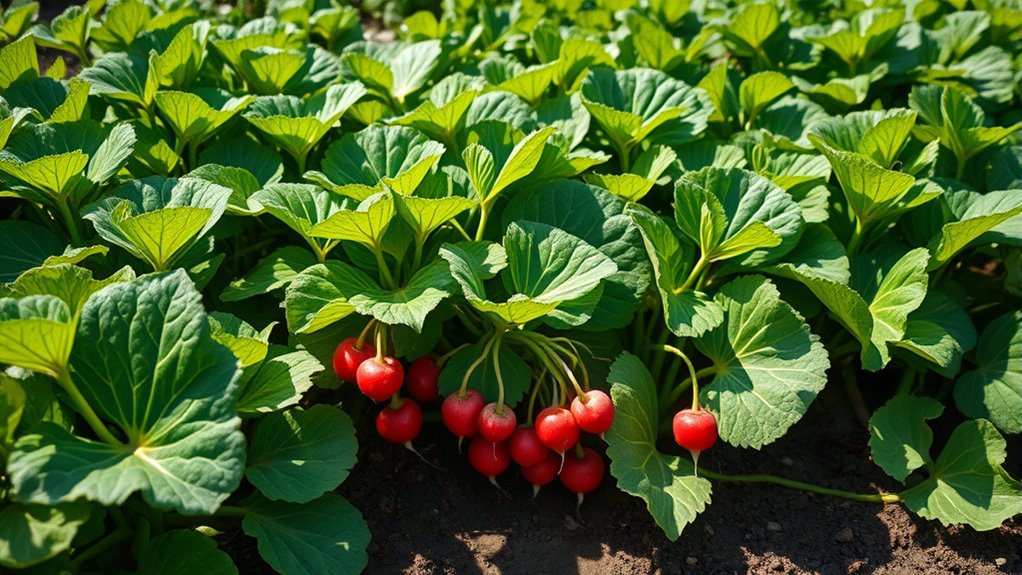
Plant radishes near your watermelon to help repel pests naturally. They also improve soil nutrients, giving your watermelon plants a healthy boost. Incorporating radishes is a simple way to support your garden’s success. Additionally, using diverse garden designs can create an inviting environment that encourages healthy plant growth.
Plant Radishes Near Watermelon
Radishes can be a great companion plant for watermelon because they grow quickly and help improve soil health. By planting radishes nearby, you can take advantage of their fast growth to maximize space and soil benefits. Radishes loosen the soil, making it easier for watermelon roots to access nutrients. They also mature in just a few weeks, allowing continuous planting and harvesting.
To make the most of this pairing, consider these tips:
- Plant radishes early in the season to prepare the soil.
- Use intercropping to maximize garden space.
- Harvest radishes before watermelon vines fully develop.
- Avoid planting radishes in overly wet or dense soil for ideal growth.
This combination promotes healthy soil and efficient use of garden space.
Repel Pests Effectively
Radishes don’t just improve soil—they also serve as effective pest repellents for watermelon plants. Their strong scent confuses and deters common pests like cucumber beetles, aphids, and squash bugs that might target your watermelons. Plant radishes around the edges of your watermelon patch to create a natural barrier. As they grow, their pungent aroma masks the scent of watermelons, making it harder for pests to locate their preferred host. Radishes mature quickly, so you can harvest them before they overshadow your watermelons. Regularly interplant radishes to maintain pest control throughout the growing season. This simple addition helps reduce the need for chemical pesticides, promoting healthier plants and a more organic approach to pest management. Additionally, understanding Kia Tuning options can help optimize your vehicle’s performance if you’re traveling to and from your garden. Incorporating integrated pest management strategies can further enhance your efforts in keeping pests at bay naturally. Using companion planting techniques like this can also improve overall crop health and yield. Proper soil health management alongside pest control can lead to more vigorous watermelon growth and better fruit quality.
Enhance Soil Nutrients
Since radishes grow quickly and develop their edible roots early, they can actively improve soil health around your watermelons. Their fast growth helps break up compacted soil, increasing aeration and water penetration. Radishes also draw nutrients from deeper soil layers, making them more available for watermelons. Additionally, they can help identify nutrient deficiencies through their vibrant root color, signaling you to adjust fertilization. To maximize benefits, consider planting radishes alongside other quick-growing cover crops. Vetting standards ensure that radishes are safe and effective for use as companion plants in watermelon cultivation. Incorporating soil improvement techniques alongside planting can further enhance crop yields and plant health.
Sweet Corn

Have you considered how sweet corn can benefit your watermelon patch? Planting sweet corn nearby can act as a natural windbreak, protecting your watermelons from strong gusts that might damage the vines. Corn also attracts pollinators like bees, which help improve fruit set for both crops. Additionally, sweet corn’s deep roots can help break up compacted soil, increasing aeration and water absorption for your watermelons. The tall stalks provide some shade, reducing soil temperature during hot days, which can help prevent water stress. Plus, corn and watermelon have similar growing requirements, making them compatible partners in your garden layout. Just ensure they’re spaced properly to avoid competition for nutrients and moisture, ensuring both crops thrive.
Legumes (Beans and Peas)

Legumes like beans and peas make excellent companions for watermelon because they enrich the soil with nitrogen through their natural fixation process. This added nitrogen boosts the growth and fruit production of your watermelon plants. Additionally, legumes can improve soil health and reduce the need for synthetic fertilizers. They also help suppress weeds by covering the ground, conserving moisture, and preventing erosion. When planting, guarantee legumes are spaced properly to avoid competition for nutrients. Incorporate nitrogen-fixing plants in your garden bed to keep the soil fertile and support healthy watermelon growth. Their root systems also loosen compacted soil, enhancing aeration. Overall, legumes are a natural, sustainable way to optimize your watermelon crop while improving your garden’s soil quality.
Eggplants

Eggplants make a beneficial companion for watermelon because they can help deter pests and improve overall garden health. Both plants thrive in similar warm conditions, making them compatible neighbors. Eggplants attract beneficial insects like predatory wasps, which can help control pests that may harm watermelon vines. Additionally, eggplants’ upright growth habit provides some shade for the soil, reducing weed growth and maintaining moisture. Keep in mind, however, that eggplants and watermelons need space to grow without competing for nutrients. Plant them at a distance to avoid overcrowding. Overall, integrating eggplants into your watermelon garden can boost your garden’s resilience and reduce pest problems, leading to healthier, more productive plants.
Frequently Asked Questions
Do Watermelon Plants Benefit From Shade Provided by Companion Plants?
You might wonder if watermelon plants benefit from shade provided by companion plants. While watermelons thrive in full sun, some shade during the hottest part of the day can help prevent heat stress and reduce water loss. Companion plants like taller beans or corn can offer this shade without competing too much for nutrients. Just make certain the shade isn’t too dense, so your watermelon still gets plenty of sunlight to grow sweet and juicy.
Can Companion Plants Help Deter Specific Pests on Watermelons?
Imagine a gardener’s secret weapon, like a shield protecting your watermelon patch. Companion plants can indeed help deter pests by attracting beneficial insects or emitting natural repellents. For example, marigolds ward off nematodes and beetles, while radishes can confuse squash bugs. By planting these allies nearby, you create a natural barrier, reducing the need for chemicals and helping your watermelons thrive in a pest-free environment.
Which Companion Plants Promote Better Soil Health for Watermelons?
You want to know which plants boost soil health for watermelons. Incorporate legumes like beans or peas, which fix nitrogen and enrich the soil. Adding aromatic herbs such as basil or mint can also improve soil quality by repelling pests and encouraging beneficial microbes. Cover crops like clover or radishes loosen compacted soil and add organic matter. These plants work together to create a healthier, more fertile environment for your watermelons to thrive.
Are There Any Plants That Inhibit Watermelon Growth or Reduce Yields?
Your garden’s growth potential is like a garden of dreams, so it’s vital to know which plants might sabotage your watermelon yield. Certain plants, like corn and potatoes, can compete for nutrients or harbor pests that harm watermelons. Also, avoid planting squash or melons nearby, as they may cross-pollinate or spread diseases. Keep these in mind to protect your watermelons and maximize your harvest’s success.
How Do Flowering Companion Plants Attract Beneficial Insects to Watermelon Crops?
You can attract beneficial insects to your watermelon crops by planting flowering companion plants nearby. These plants produce nectar and pollen, which attract pollinators like bees and predatory insects such as ladybugs and parasitic wasps. As a result, these beneficial insects help improve pollination and naturally control pests. By choosing vibrant, nectar-rich flowers, you create an inviting environment that encourages insects to visit and support your watermelon plants’ health and productivity.
Conclusion
So, now you know the secret to watermelon greatness: a little plant party in your garden. Just imagine, with basil, marigolds, and radishes as your sidekicks, your melons will be the envy of every backyard barbecue. Who knew that planting a few companions could turn your garden into the botanical equivalent of a blockbuster? So go ahead, get planting—your watermelons will thank you, and maybe even forgive you for that questionable sun hat.
